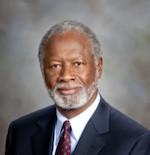House Speaker Bob Cupp, center right, and state Sen. Vernon Sykes, far right, co-chairs of the Ohio Redistricting Commission, speak to media after a January meeting to restart the legislative redistricting process. The ORC now has to deal with congressional and legislative redistricting at the same time as an Ohio Supreme Court deadline for congressional maps is up next month, and the commission passed by a Feb. 17 deadline for GA maps. (Photo: Susan Tebben, OCJ)
The newest congressional redistricting effort will have to share the stage as the Ohio Redistricting Commission meets with legislative districts still up in the air, with their next meeting scheduled for 4 p.m. Wednesday.
The Ohio Redistricting Commission met on Tuesday afternoon for about ten minutes to start a new congressional redistricting plan after its previous effort was shot down by the Ohio Supreme Court.
In those ten minutes, ORC co-chair House Speaker Bob Cupp set the expectation of two more congressional redistricting hearings, and fellow co-chair state Sen. Vernon Sykes, D-Akron, invited organizations and individuals who have previously submitted complete district plans to resubmit them and present them this week.
As the congressional process began, Gov. Mike DeWine interrupted to reemphasize the currently missing legislative districts.
“This is, I think a question of following the law, the rule of law, respect for the law,” DeWine said. “And I, again, want to state that that’s where we should head.”
DeWine voted in favor of the last two redistricting maps, despite saying he wished negotiations had continued in an attempt to come to bipartisan agreement.
Senate President Matt Huffman jumped in to “echo the governor’s comments.”
At the Feb. 17 meeting of the ORC to talk legislative redistricting, Huffman led the charge in saying the commission couldn’t follow the Ohio Supreme Court directions for the General Assembly maps while also following the rules set forth in the constitutional amendment regarding redistricting.
The governor and his fellow commissioners could be held in contempt for missing the Feb. 17 deadline the Ohio Supreme Court ordered for them to present a third set of General Assembly districts. The court found the previous two efforts unconstitutional, and said they favored the GOP over the Democrats in a way that did not match statewide voter preferences over the last 10 years.
The court is awaiting responses from the ORC members as to why they shouldn’t be held in contempt, responses which are due by noon Wednesday.
Auditor Keith Faber also wanted the commission to come back to redistricting, going so far as to move that the ORC schedule two more meetings this week.
“I just think it’s important that we move forward on discussing either A, or B, or C, or D,” Faber said. “But I would propose that we schedule a meeting to do that.”
Secretary of State Frank LaRose supported the motion for more meetings. He’s spent a fair amount of time at recent ORC meetings expressing the urgency with which he thinks this process needs to happen to meet primary election deadlines.
The Feb. 22 deadline for the Secretary of State’s office to certify ballots for the May 3 election has already passed, and the April 4 deadline for voter registration in the May primary is fast approaching.
LaRose already warned the commission that they are in danger of violating federal law if the state misses the March 18 deadline to have absentee ballots ready for uniformed and overseas citizens.
May 3 Election
After the meeting, LaRose’s office sent out directives regarding official ballots to be used in the May 3 primary, which specifically “does not apply to the offices of U.S. Representative to Congress, Ohio General Assembly and State Central Committee.”
He also sent a letter to Huffman on Tuesday, saying “new developments have introduced even more uncertainty to an already unprecedented election calendar.”
He said the impasse reached on legislative redistricting was one of those developments, but even more urgent were the deadlines being missed “essential to the administration of a successful May 3, 2022, primary election.”
“Nevertheless, I have directed our 88 county boards of elections to proceed with and prepare for an election on that date for offices that are not impacted by redistricting, specifically contests for statewide and local offices,” LaRose wrote.
LaRose said any further delay in the redistricting process “will not allow adequate time to complete the programming, testing and mock election schedule” before the May primary.
“Let me be clear on this point: it is impossible to see a scenario in which these maps are favorably passed by the Redistricting Commission, challenged by litigants, reviewed by a court, and given final approval within a timeframe conducive to a May 3, 2022, primary election date,” the letter stated.
With two weeks before the filing deadline for U.S. House of Representative candidates, LaRose said it is already “administratively impossible” for county boards of elections to meet those deadline, even in the already expedited schedule. Attempting to do so would lead to “confusion, unintentional mistakes, potential additional litigation outside the protest process, as well as chaos for election officials, candidates and most importantly voters.”
He said proceeding without the congressional and legislative districts set in stone forces the GA to make decisions, including whether to move the entire primary, or go with a divided primary, that is two different primary dates. The other primary would be held “at a date to be determined in August,” LaRose wrote.
Huffman had previously posed the idea of two primary dates, but recently told reporters the idea went over like a “lead balloon.”
Elections groups have criticized the idea as immensely expensive and administratively cumbersome.
More meetings this week
Cupp said the Wednesday meeting would “serve a dual purpose,” to “begin a hearing on a congressional map, as well as to record any progress that may be made in the General Assembly district map.”
When Faber pushed to have more meetings on the GA maps, he mentioned a map that”may be being discussed and/or prepared” or the alternative, the third version of a map by Stanford professor Jonathan Rodden, which has a 52-45 partisan breakdown, according to Dave’s Redistricting App.
“I certainly would be wanting to make some amendments to Rodden III, but if you could make those amendments and keep some of the concepts the same, I think it’s maybe a road map for a solution,” Faber said.
In Ohio Supreme Court documents, justices noted that Huffman took issue with Rodden’s map, saying his analysis used different voter databases than those that drew the GOP map. Rodden also criticized the last GOP-approved congressional map as creating an overwhelming GOP advantage, along with cracking apart Black communities, like those in Cincinnati.
One of the parties both legislative and congressional lawsuits, however, sees the Rodden map as a fine place to begin, and asking for previously submitted maps as a starting point isn’t a bad idea.
“There are district maps that have been submitted that are far better than what’s been adopted, so starting there is great,” said Jen Miller, executive director of the League of Women Voters of Ohio.
Democrats once again asked to be brought into the process, something they say isn’t happening yet in the congressional process.
“It should be the commission’s (redistricting) plan, and (House Minority) Leader (Allison) Russo has raised the issue of whether or not everybody’s involved int he conversation that’s going on now,” Sykes said after Tuesday’s meeting.
• • •• • •
This story is provided by Ohio Capital Journal, a part of States Newsroom, a national 501 (c)(3) nonprofit. See the original story here.




















